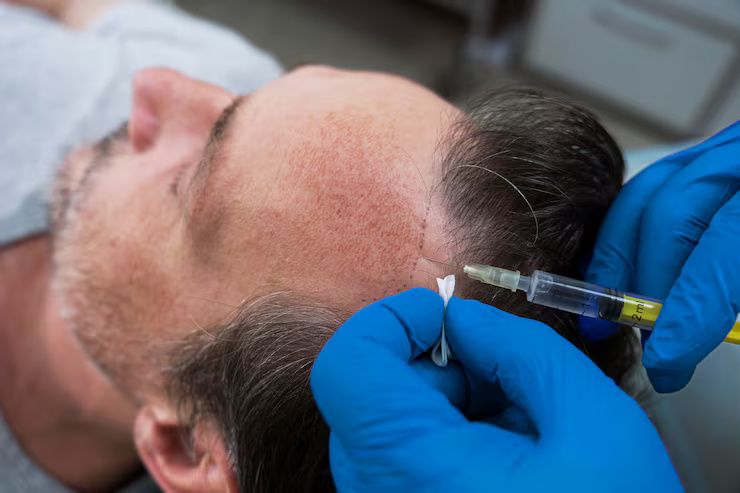A hair transplant is a medical procedure that moves hair follicles from one part of the body (commonly the back or sides of the scalp) to an area experiencing hair loss or thinning, such as the crown or hairline. It’s commonly used to treat male-pattern baldness, but also assists individuals affected by trauma, surgery, or medical conditions causing hair loss.
Hair transplant procedures are classified under cosmetic dermatology and have become increasingly advanced and minimally invasive with modern techniques like FUE (Follicular Unit Extraction) and FUT (Follicular Unit Transplantation).

Importance – Why hair transplants matter today
Hair loss affects millions of individuals globally, often impacting self-esteem and quality of life. With stress, hormonal changes, hereditary conditions, and poor nutrition on the rise, more people are seeking long-term solutions.
Hair transplants matter today because they:
-
Offer a permanent solution for many types of hair loss
-
Are minimally invasive and safe when performed by certified professionals
-
Help boost confidence for people experiencing early or advanced hair loss
-
Can be customized for facial hair (beard, eyebrows) as well as scalp
The demand has grown across both men and women, especially in younger demographics who want preventive interventions.
Recent Updates – Trends and changes in hair restoration (2024–2025)
The last year has seen several advancements and shifts in the hair transplant field:
-
Robotic Hair Transplant Systems: Devices like ARTAS® have been upgraded to improve graft precision and reduce procedure time.
-
Stem Cell and PRP Integration: Platelet-rich plasma therapy is now frequently used post-transplant to boost follicle health and growth.
-
Increased Demand for Beard and Eyebrow Transplants: Cosmetic trends have made facial hair restoration more popular.
-
International Medical Tourism: Countries like Turkey, India, and Thailand have seen a surge in hair transplant tourism due to affordability and skilled surgeons.
-
AI-Powered Simulations: Clinics now use AI to simulate post-procedure results, helping patients set realistic expectations.
These trends reflect a move toward patient customization, improved recovery times, and more natural-looking results.
Laws or Policies – Regulations that apply to hair transplants
Hair transplants are regulated differently across countries, especially when categorized as elective cosmetic procedures:
India
Hair transplants must be performed by registered medical practitioners with MBBS and dermatology specialization. As per the National Medical Commission guidelines, any surgical cosmetic procedure requires certification and must be conducted in a licensed medical facility.
United States
The FDA regulates equipment used in hair restoration. The American Board of Hair Restoration Surgery (ABHRS) is a recognized credentialing board for surgeons. Clinics must comply with OSHA standards for hygiene and medical practice.
United Kingdom
Clinics are regulated by the Care Quality Commission (CQC), and practitioners must be registered with the General Medical Council (GMC). Advertising guidelines are strictly monitored by the ASA to prevent misleading claims.
Patients are advised to verify surgeon credentials, clinic accreditation, and post-surgery care facilities to ensure safety.
Tools and Resources – Helpful apps, websites, and guides for planning
Here are some useful platforms and tools for researching or preparing for a hair transplant:
Apps and Calculators
-
HairMetrix – Offers visual density analysis for hair loss stages
-
Graft Calculator – Used to estimate the number of hair grafts needed
-
SkinVision – Skin and scalp health monitoring before transplant
Websites and Directories
-
ISHRS.org – Official site of the International Society of Hair Restoration Surgery
-
RealSelf – Independent patient reviews and cost breakdowns
-
Zocdoc / Practo – Doctor appointment platforms with verified clinics
Templates and Planners
-
Post-transplant care checklist
-
Daily recovery tracker
-
Budget planning sheet for transplant procedure
FAQs – Common questions about hair transplants
Q1. Is a hair transplant permanent?
Yes, transplanted hair is generally permanent as it comes from the donor area, which is typically resistant to balding. However, ongoing hair loss in untreated areas may continue.
Q2. How long is the recovery process after a hair transplant?
Initial healing takes about 7–10 days. Full visible hair growth may take 6–12 months. During this time, mild shedding of transplanted hair is normal.
Q3. Is the procedure painful?
The surgery is performed under local anesthesia. Patients may feel mild discomfort during recovery, which is usually managed with prescribed medication.
Q4. How much does a hair transplant cost?
Cost varies based on location, number of grafts, and technique. In India, it may range from ₹40,000–₹1,50,000; in the U.S., it could go from $4,000 to $15,000.
Q5. Are there risks involved?
Side effects are rare but can include infection, scarring, or uneven hair growth. Choosing a licensed and experienced surgeon significantly reduces risk.
Final thoughts
Hair transplants have emerged as a reliable and increasingly popular method to combat hair loss. With technological improvements and safer procedures, the process has become more accessible and efficient.
However, not everyone is a candidate. Before undergoing surgery, it’s essential to consult with certified professionals, understand potential outcomes, and commit to proper aftercare. With the right planning and information, a hair transplant can be a transformative but medically sound choice.